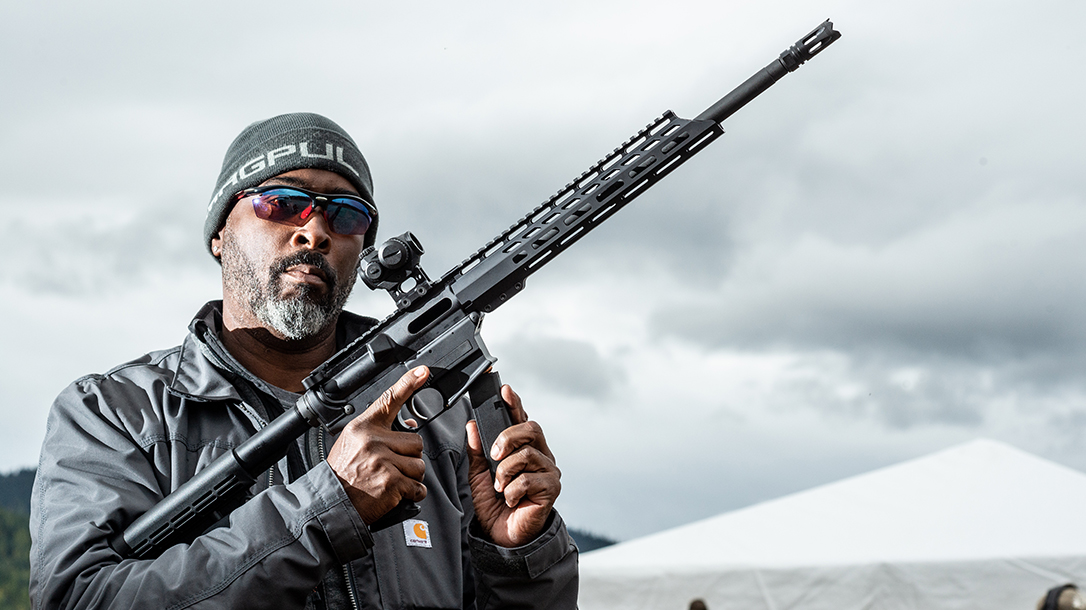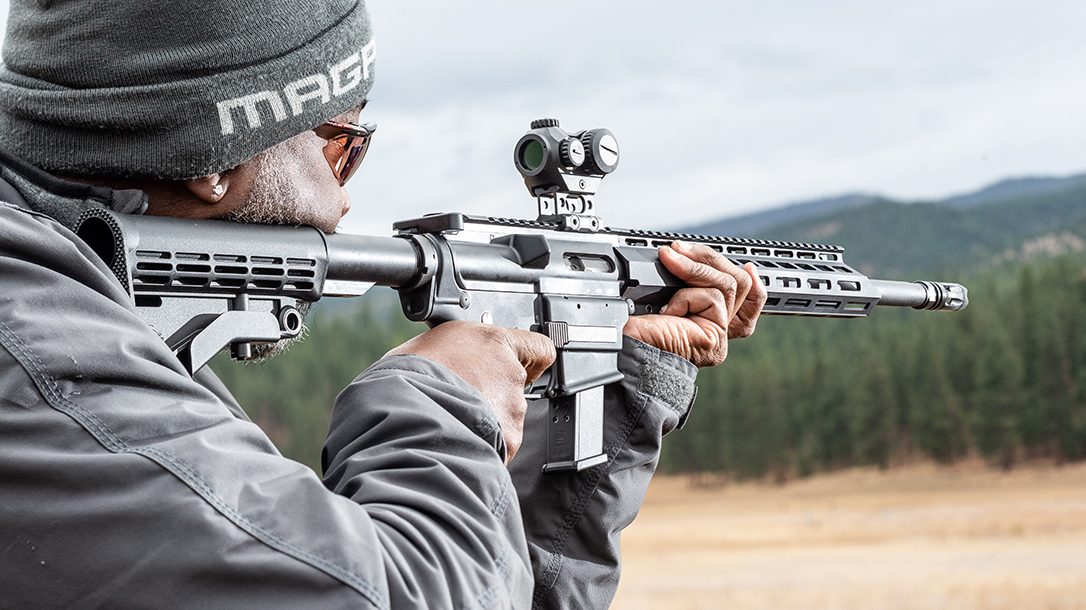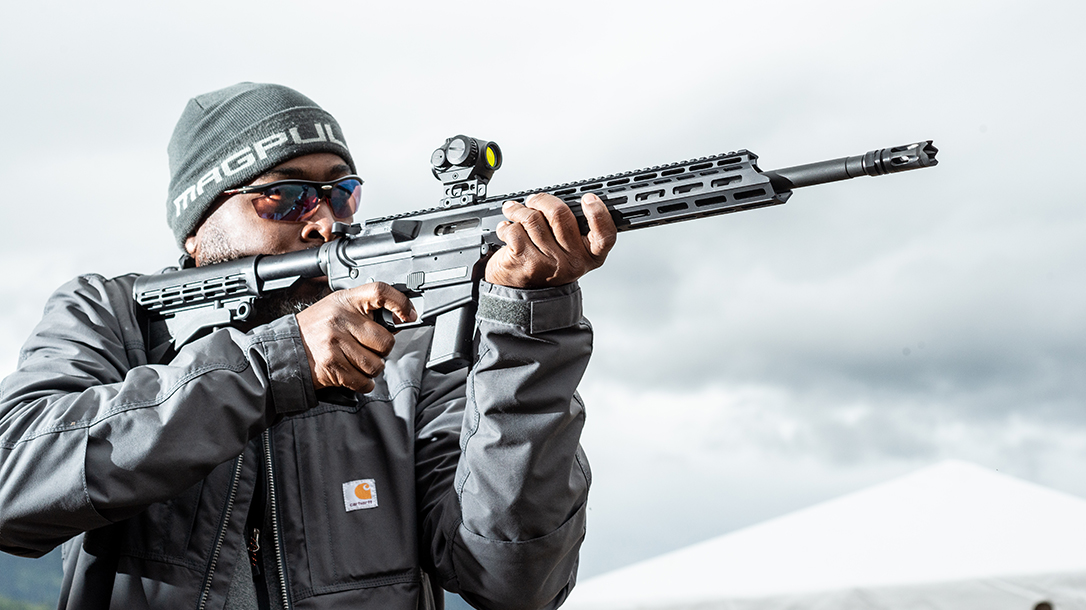The pistol-caliber carbine genre continues to expand and the Anderson Manufacturing AM-9 entry is one worth exploring further.
The AM-9 features a forged 7075 T-6 lower receiver, a closed bolt, blowback operating system with a 9mm, 16-inch 1:10 twist barrel.
Advertisement — Continue Reading Below
Anderson designed the AM-9 to utilize the popular Glock 9mm magazines. The lower receiver features a flared magwell, oversized magazine release, and bolt stop to speed up reloading time. The AM-9 weighs in at 7 pounds — an advantage of the pistol caliber carbine is often lighter than its 16-inch rifle brethren.
Use of Pistol-Caliber Carbines
Pistol caliber carbines have become more prevalent with shooters viewing them as a possible alternative long-arm for personal defense, as well as growing stand alone classification on the competition circuit. My caliber of choice for a pistol caliber carbine is the 9mm due to magazine capacity; this is especially true if the model utilizes a Glock-style magazine, combined with preponderance of reasonably priced ammunition offerings.
Some will question the utility of employing a pistol cartridge in a shoulder fired weapon. I would counter that most engagements happen well within a 100 yards — especially in civilian settings — with handling and reliability playing more of a factor in quick, reactive engagements than specific caliber used.
Advertisement — Continue Reading Below
Also, less experienced shooters will find the lower recoil impulse and muzzle blast of a pistol caliber fired from the shoulder easier to manage, which often translates to better accuracy.
The 9mm Chambering
The 9mm pistol cartridge chambered in a carbine is a much more potent package than any handgun. The advantage is derived from the increased accuracy found in a pistol-caliber carbine; this is based on multiple points of contact when interfaced with the shooter. This consists of shoulder, cheek, and hands spread further apart for more stability compared to when handling a handgun.
The muzzle blast differential between a 9mm carbine versus rifle muzzle signature is further accentuated in confined spaces. Many more 9mm rounds can be carried in less space compared to rifle rounds. Two slim high capacity 9mm magazines fit into the same space as one M16/AR-15 magazine.
Advertisement — Continue Reading Below
There is an economic incentive in terms of the amount of purchasable 9mm rounds versus a rifle cartridge. This can be taken advantage of with more training and access to indoor ranges where rifles are usually verboten.
Training regimen is further enhanced by the 9mm carbine’s ability to be used with steel plate targets without having to resort to specialty frangible rifle loads at close ranges.
Advertisement — Continue Reading Below
The old standard touting the advantage of having both a carbine and handgun chambered in the same caliber should not be casually dismissed either, especially if an organized logistics chain cannot be counted on. A carbine and handgun accepting the same magazine is an added bonus. Not to delve off into worst case scenarios, but too many people are stocking up ammunition, food and weapons in these times of worry to totally discount the sentiment.
9mm vs. 5.56mm/.223 Rem
There are several main differences between the 9mm AR and 5.56mm/.223 Rem AR; these differences relate to the 9mm AR working via blowback operation compared to gas impingement for the rifle-chambered AR.
The bolt carrier on the 9mm AR needs to be much heavier due to this operating method. It is one piece, as compared to the 5.56/.223 rotating bolt head. The bolt still recoils into the buffer tube located in the stock; thus side folding stocks are not an option with the 9mm ARs.
Advertisement — Continue Reading Below
The 9mm bolt face is integral to the bolt and different in configuration due to making room for ejector that protrudes up from magblock sliding along its length.
Lastly, there are no rotating/locking lugs on the 9mm bolt face.
Testing the Anderson Manufacturing AM-9
I had an opportunity to evaluate the Anderson Manufacturing AM-9 at the 2018 Athlon Rendezvous held in Missoula, Mont.
Advertisement — Continue Reading Below
The AM-9 was sighted 1-inch high at 25 yards, which gives an approximate 50-yard zero and -7-inch low at 100 yards; this is a flatter trajectory than most would expect.
Anderson mounted one of its recently introduced red dots. I hammered an array of steel targets from 15 yards out to 150 yards off and on for nearly a day.
Anderson Manufacturing AM-9 Final Thoughts
The pistol-caliber carbine makes far more sense than relying strictly on a handgun for defense, especially in rural areas. If an unseasoned member of the family is involved, this is only magnified.
Advertisement — Continue Reading Below
Accurate hits are possible out to 100 yards with the Anderson Manufacturing AM-9 red dot carbine after only minimal practice.
The AM-9 is one of the new breed of specifically designed pistol-caliber carbines. It takes the pistol-caliber carbine concept to fruition for the civilian concerned with either personal defense or competition … or those simply looking to enjoy shooting in the most efficient manner.
For more information, please visit AndersonManufacturing.com.
Advertisement — Continue Reading Below
Anderson Manufacturing AM-9 Specs
- Caliber: 9mm
- Barrel: 16 inches; 1:10 twist
- OA Length: 40 inches
- Weight: 7 pounds
- Sights: Flat top Picatinney rail for mounting of optics or iron sights
- Action: Semi-auto
- Finish: Parkerized finish on the upper and hard coat anodized aluminum lower
- MSRP: $973


























